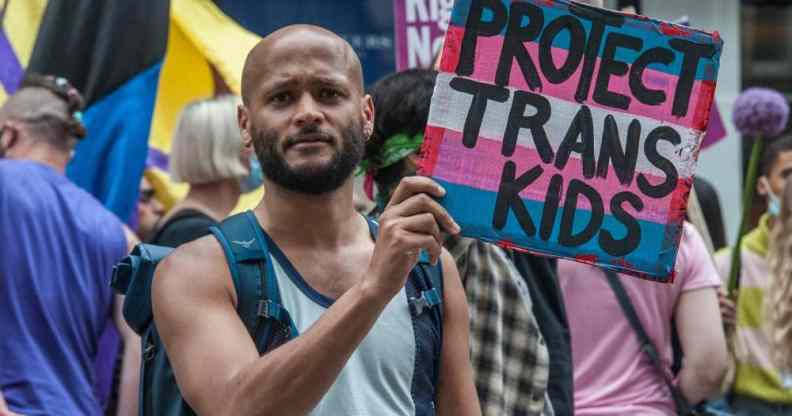New York Times faces searing backlash for publishing ‘harmful’ anti-trans ‘propaganda’: ‘Do better’

People online are criticising the New York Times for publishing an article that uncritically platformed anti-trans voices when talking about gender-affirming medical care for trans youth. (Getty/Guy Smallman)
The New York Times is facing fierce backlash after it published an article full of “anti-trans propaganda” under the guise of “concern-trolling”.
The outlet published an article titled “The Battle Over Gender Therapy” Wednesday (15 June) in its New York Times Magazine which uncritically platformed gender-critical groups, vile rhetoric and anti-trans parents. The article claimed there was a “big debate among clinicians” on how they should “respond to the thousands of teenagers who are arriving at their doors” for gender-affirming treatments.
It claimed that a December draft of the World Professional Association for Transgender Health’s (WPATH) standards of care (SOC8) on adolescents raised “tricky questions” about young people accessing gender-affirming care.
These so-called questions included if trans teens coming out today were “different from the adults who transitioned in previous generations” or if some young people “struggling with serious mental-health issues” might be “trying to shed aspects of themselves they dislike” by transitioning.
The article also claimed the “prevalence” of young people coming out has increased in recent years, and journalist Emily Bazelon said “some clinicians” told her the “average age when a young person first comes” to a gender clinic “tends to be around 14 or 15”.
The New York Times Magazine article cast the ability to access gender-affirming care for minors as a simple decision despite the fact most clinics in the US have years-long wait lists, assessments can be lengthy and treatments can be costly.
The December draft of WPATH SOC8, seen by Bazelon, recommended minors provide evidence of “several years” of identifying as their chosen gender before accessing medical treatment.
It was then advised trans youth “undergo a comprehensive diagnostic assessment, for the purpose of understanding the psychological and social context of their gender identity and how it might intersect with other mental-health conditions”.
Several people online blasted the New York Times for publishing the “dangerous” anti-trans article and argued it cast “reactionary backlash as legitimate debate about transition care”.
The NYT just platformed a group made up of transphobic parents & conversion therapists who’ve written about how they have the same end goals as hardline trans eliminationists but moderate their views to try to break into the mainstream. This is dangerous & irresponsible.
— Ky Schevers (@reclaimingtrans) June 15, 2022
The article also uncritically platformed gender-critical group Genspect, and the New York Times Magazine’s article said the group has held “web-based seminars that are critical of social and medical transition”.
Some parents, who are part of Genspect, told Bazelon that they believed the “rise in trans-identified teenagers was the result of a ‘gender cult’ – a mass craze”. Other parents said trans people shouldn’t be able to access gender-affirming treatments until they are 25, “when brain development is largely complete.”
With the inclusion of such widely-reviled groups, people online questioned if The New York Times considered hiring a trans journalist when writing about trans issues or if the outlet believed “only a cis journalist can be ‘objective'”.
There was a small speck of good news from the New York Times Magazine article. The final version of the WPATH SOC8 adolescent chapter dropped the requirement that trans youth must show years of identifying as trans in order to obtain gender-affirming healthcare.
Instead, it reportedly will ask if a young person’s trans identity is “marked and sustained over time”, which is an improvement from the previous draft.
A spokesperson for The New York Times defended the article, telling PinkNews: “This is a deeply-researched piece of reporting on an important issue currently prominent in the national discussion.
“Over the eight months Emily reported on this story, she talked to more than 60 clinicians, researchers, activists and historians, as well as more than two dozen young people and about the same number of parents. The story includes interviews and perspectives of a number of trans individuals.
“The story centres on the Standards of Care, a set of guidelines issued by the World Professional Association of Transgender Health. The Standards are being updated for the first time in a decade, with trans and non-binary practitioners helping to write and oversee them.
“They influence the positions taken by major medical groups, including the American Academy of Pediatrics and the American Psychological Association, and the coverage offered by health insurers and national health services around the world.
“The update of these standards, and the divisions within the field around them, is newsworthy.”

